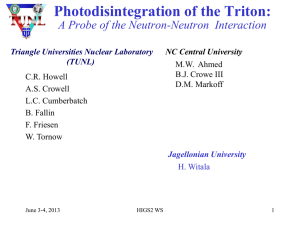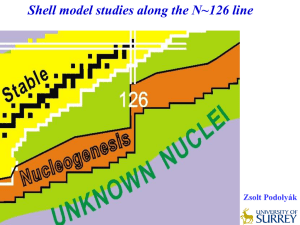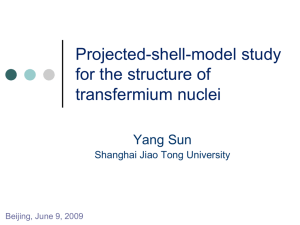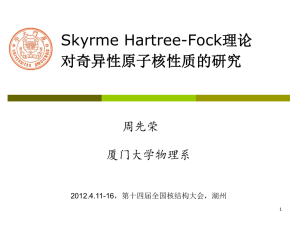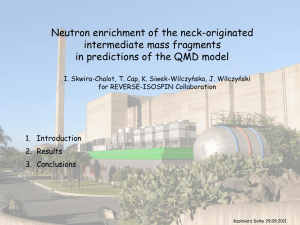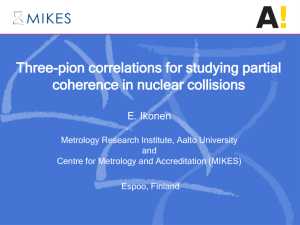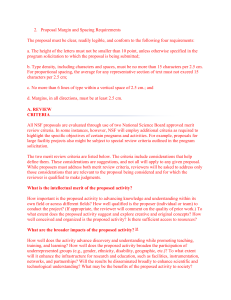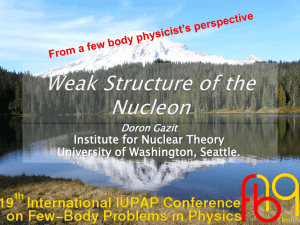WhitepaperSession3
advertisement
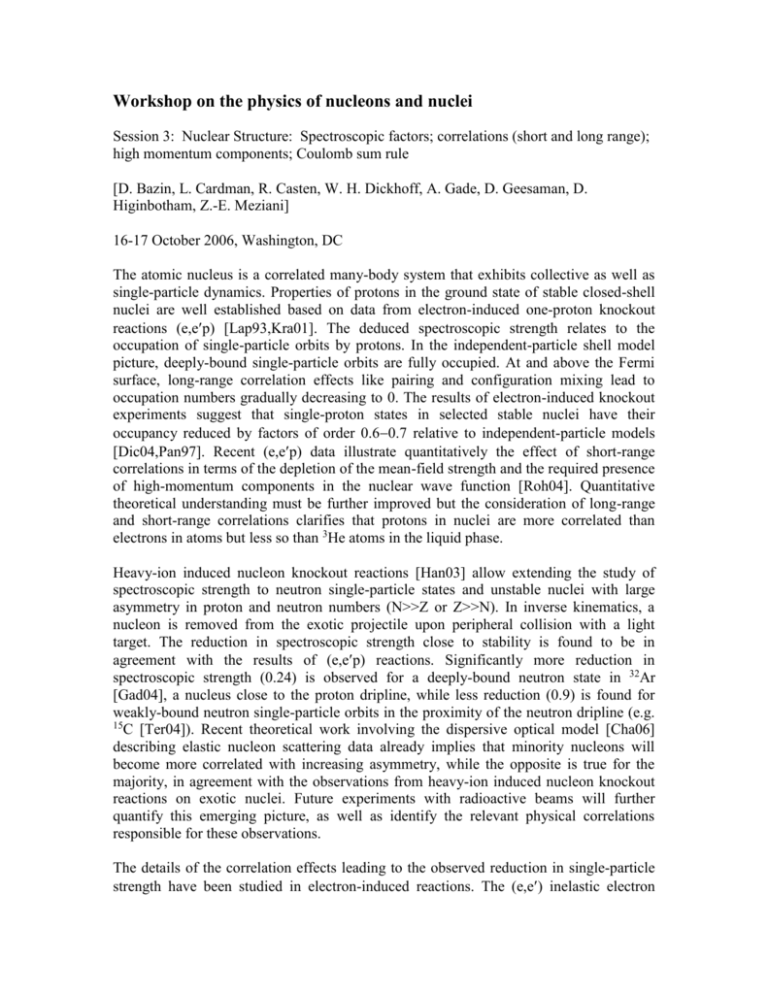
Workshop on the physics of nucleons and nuclei Session 3: Nuclear Structure: Spectroscopic factors; correlations (short and long range); high momentum components; Coulomb sum rule [D. Bazin, L. Cardman, R. Casten, W. H. Dickhoff, A. Gade, D. Geesaman, D. Higinbotham, Z.-E. Meziani] 16-17 October 2006, Washington, DC The atomic nucleus is a correlated many-body system that exhibits collective as well as single-particle dynamics. Properties of protons in the ground state of stable closed-shell nuclei are well established based on data from electron-induced one-proton knockout reactions (e,ep) [Lap93,Kra01]. The deduced spectroscopic strength relates to the occupation of single-particle orbits by protons. In the independent-particle shell model picture, deeply-bound single-particle orbits are fully occupied. At and above the Fermi surface, long-range correlation effects like pairing and configuration mixing lead to occupation numbers gradually decreasing to 0. The results of electron-induced knockout experiments suggest that single-proton states in selected stable nuclei have their occupancy reduced by factors of order 0.60.7 relative to independent-particle models [Dic04,Pan97]. Recent (e,ep) data illustrate quantitatively the effect of short-range correlations in terms of the depletion of the mean-field strength and the required presence of high-momentum components in the nuclear wave function [Roh04]. Quantitative theoretical understanding must be further improved but the consideration of long-range and short-range correlations clarifies that protons in nuclei are more correlated than electrons in atoms but less so than 3He atoms in the liquid phase. Heavy-ion induced nucleon knockout reactions [Han03] allow extending the study of spectroscopic strength to neutron single-particle states and unstable nuclei with large asymmetry in proton and neutron numbers (N>>Z or Z>>N). In inverse kinematics, a nucleon is removed from the exotic projectile upon peripheral collision with a light target. The reduction in spectroscopic strength close to stability is found to be in agreement with the results of (e,ep) reactions. Significantly more reduction in spectroscopic strength (0.24) is observed for a deeply-bound neutron state in 32Ar [Gad04], a nucleus close to the proton dripline, while less reduction (0.9) is found for weakly-bound neutron single-particle orbits in the proximity of the neutron dripline (e.g. 15 C [Ter04]). Recent theoretical work involving the dispersive optical model [Cha06] describing elastic nucleon scattering data already implies that minority nucleons will become more correlated with increasing asymmetry, while the opposite is true for the majority, in agreement with the observations from heavy-ion induced nucleon knockout reactions on exotic nuclei. Future experiments with radioactive beams will further quantify this emerging picture, as well as identify the relevant physical correlations responsible for these observations. The details of the correlation effects leading to the observed reduction in single-particle strength have been studied in electron-induced reactions. The (e,e) inelastic electron scattering reaction probes high-momentum nucleons in the two-nucleon short-range correlation (2N SRC) phase. From the 12C(e,e) reaction, the amount of 2N SRC has been estimated to 20(5)% [Egi03] - including nn, pp, and np correlations. Recent electron scattering experiments found that multi-nucleon SRC amount to 1% or less of the total correlations [Egi06]. For stable nuclei, the picture drawn by experiment and theory to date is that 80(5)% of the nucleons move in an average potential – 60-70% can be described as single particles in a shell-model potential, 10-20% are subject of long-range correlations. 20(5)% are governed by 2N SRC while multi-nucleon corrections amount to less than 1%. The relative contributions of nn, np, and pp to the 2N SRC phase are being investigated with (e,epp) and (e,epn) probes. Two-nucleon short-range correlations have also been explored by measuring the longitudinal response function RL and evaluating the Coulomb sum, namely its first moment with respect to the excitation energy for a fixed momentum transfer q. For large enough q (greater than twice the Fermi momentum, ~ 500 MeV/c), the Coulomb sum deviation from unity can be shared between the 2N SRC effects and a possible modification of the free nucleon electromagnetic form factors in the nuclear medium. While the 2N SRC has been studied extensively and their contribution shown to be small (less than 10%) at large q, medium effects on the properties of bound protons are still under experimental investigation through the Coulomb sum study. New measurements of quasi-elastic (e,e’) scattering from light (4He) to heavy ( 208Pb) nuclei in the range 0.5 < q < 1 GeV/c where short range correlations are small are planned at Jefferson Lab to determine the Coulomb sum [Che05]. Consequently observed large deviation (> 20%) of the sum from unity might be evidence of medium effects on the free nucleon form factors. Such large deviations have not been observed in light nuclei up to 4He, but for medium weight and heavy nuclei the situation is controversial but will be resolved by this newly planned experiment. An independent investigation of medium effects of protons in (4He) through the extraction of the ratio of the electric over the magnetic proton form factors is underway. This ratio is determined from a measurement of the longitudinal to normal polarizations transfer ratio of the outgoing protons in the 4He(e,e’p)3H reaction [Str03]. A recent measurement [Ent03] will improve on the statistical precision of the previous one, which is suggestive of possible medium effects in 4He but not conclusive. Precision data in both experimental techniques is crucial to unravel the effects of 2N SRC and nuclear medium effects on the bound nucleon. [Lap93] L. Lapikas et al., Nucl. Phys. A553 (1993) 297c. [Kra01] G. J. Kramer et al., Nucl. Phys. A679 (2001) 267. [Dic04] W. D. Dickhoff and C. Barbieri, Prog. in Part. and Nucl. Phys. 52 (2004) 377. [Pan97] V. R. Pandharipande et al., Rev. Mod. Phys. 69 (1997) 981. [Roh04] D. Rohe et al., Phys. Rev. Lett 93 (2004) 182501. [Han03] P.G. Hansen and J. A. Tostevin, Annu. Rev. Nucl. Part. Sci. 53 (2003) 219. [Gad04] A. Gade et al., Phys. Rev. Lett. 93 (2004) 042501. [Ter04] J. R. Terry et al., Phys. Rev. C 69 (2004) 054306. [Cha06] R. J. Charity et al., Phys. Rev. Lett. 97 (2006) 162503. [Egi03] K. Sh. Egiyan et al., Phys. Rev. C 68 (2003) 014313. [Egi06] K. Sh. Egiyan et al., Phys. Rev. Lett. 96 (2006) 082501. [Che05] J.-P. Chen, S. Choi and Z.-E. Meziani, spokespersons, JLab experiment E05110. [Ent03] R. Ent, R. Ransome, S. Strauch, P. Ulmer, spokespersons, JLab pexperiment E03-104. [Str03] S. Strauss et al., Phys. Rev. Lett. 91 (2003) 052301


